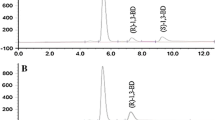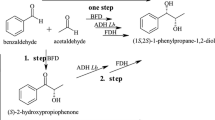Abstract
Optically pure 1-(3’,4’-methylenedioxyphenyl) ethanol is a key chiral intermediate for the synthesis of Steganacin and Salmeterol. A para-nitrobenzyl esterase cloned from Bacillus amyloliquefaciens (BAE) was employed to hydrolyze 1-(3’,4’-methylenedioxyphenyl) ethyl ester for the production of (R)-1-(3’,4’-methylenedioxyphenyl)ethanol. Initially, a moderate enantioselectivity (E = 35) only was obtained at 30°C. Some reaction conditions such as reaction temperature and additive approach were investigated in order to improve the enantioselectivity of the BAEcatalyzed reaction.. As a result, the enantioselectivity was improved significantly to 140 under addition of Tween-80 and a decreasing reaction temperature to 0°C. The result was confirmed in a decagram-scale preparative bioresolution also. The optimized enzymatic hydrolysis conditions provide a more effective process for the (R)-1-(3’,4’-methylenedioxyphenyl) ethanol bioproduction.
Similar content being viewed by others
Refrerences
Joncour, A., A. Décor, J. M. Liu, M. E. Tran Huu Dau, and O. Baudoin (2007) Asymmetric synthesis of antimicrotubule biaryl hybrids of allocolchicine and steganacin. Chem. Eur. J. 13: 5450–5465.
Johnson, M. (1995) Salmeterol. Med. Res. Rev. 15: 225–257.
Hashiguchi, S., A. Fujii, K. J. Haack, K. Matsumura, T. Ikariya, and R. Noyori (1997) Kinetic resolution of racemic secondary alcohols by RuII-catalyzed hydrogen transfer. Angew. Chem. Int. Ed. 36: 288–290.
Wettergren, J., A. Bøgevig, M. Portier, and H. Adolfsson (2006) Ruthenium-catalyzed enantioselective reduction of electron-rich aryl alkyl ketones. Adv. Synth. Catal. 348: 1277–1282.
Wang, M. C., Q. J. Zhang, W. X. Zhao, X. D. Wang, X. Ding, T. T. Jing, and M. P. Song (2008) Evaluation of enantiopure N-(ferrocenylmethyl) azetidin-2-yl (diphenyl) methanol for catalytic asymmetric addition of organozinc reagents to aldehydes. J. Org. Chem. 73: 168–176.
Wang, M. C., Q. J. Zhang, G. W. Li, and Z. K. Liu (2009) Highly enantioselective addition of dimethylzinc to arylaldehydes catalyzed by (2S)-1-ferrocenyl-methylaziridin-2-yl (diphenyl) methanol. Tetrahedron: Asymmetry 20: 288–292.
Koul, S., J. L. Koul, B. Singh, M. Kapoor, R. Parshad, K. S. Manhas, S. C. Taneja, and G. N. Qazi (2005) Trichosporon beigelli esterase (TBE): A versatile esterase for the resolution of economically important racemates. Tetrahedron: Asymmetry 16: 2575–2591.
Zock, J., C. Cantwell, J. Swartling, R. Hodges, T. Pohl, K. Sutton, P. Rostek, Jr., D. McGilvray, and S. Queener (1994) The Bacillus subtilis pnbA gene encoding p-nitrobenzyl esterase: Cloning, sequence and high-level expression in Escherichia coli. Gene 151: 37–43.
Arnold, F. H. and J. C. Moore (1998) Para-nitrobenzyl esterases with enhanced activity in aqueous and nonaqueous media. US Patent 5,741, 691.
Arnold, F. H. and L. J. Giver (1999) Thermally stable paranitrobenzyl esterases. US Patent 5,945, 325.
Henke, E. and U. T. Bornscheuer (2002) Esterases from Bacillus subtilis and B. stearothermophilus share high sequence homology but differ substantially in their properties. Appl. Microbiol. Biotechnol. 60: 320–326.
Heinze, B., R. Kourist, L. Fransson, K. Hult, and U. T. Bornscheuer (2007) Highly enantioselective kinetic resolution of two tertiary alcohols using mutants of an esterase from Bacillus subtilis. Protein Eng. Des. Sel. 20: 125–131.
Kourist, R., S. Bartsch, and U. T. Bornscheuer (2007) Highly enantioselective synthesis of arylaliphatic tertiary alcohols using mutants of an esterase from Bacillus subtilis. Adv. Synth. Catal. 349: 1393–1398.
Barbayianni, E., C. G. Kokotos, S. Bartsch, C. Drakou, U. T. Bornscheuer, and G. Kokotos (2009) Bacillus subtilis esterase (BS2) and its double mutant have different selectivity in the removal of carboxyl protecting groups. Adv. Synth. Catal. 351: 2325–2332.
Wiggers, M., J. Holt, R. Kourist, S. Bartsch, I. Arends, A. J. Minnaard, U. T. Bornscheuer, and U. Hanefeld (2009) Probing the enantioselectivity of Bacillus subtilis esterase BS2 for tert. alcohols. J. Mol. Catal. B: Enzymatic 60: 82–86.
Zheng, G. W., H. L. Yu, J. D. Zhang, and J. H. Xu (2009) Enzymatic production of l-menthol by a high substrate concentration tolerable esterase from newly isolated Bacillus subtilis ECU0554. Adv. Synth. Catal. 351: 405–414.
Liu, J. Y., G. W. Zheng, C. X. Li, H. L. Yu, J. Pan, and J. H. Xu (2013) Multi-substrate fingerprinting of esterolytic enzymes with a group of acetylated alcohols and statistic analysis of substrate spectrum. J. Mol. Catal. B: Enzymatic 89: 41–47.
Zhao, L. L., J. H. Xu, J. Zhao, J. Pan, and Z. L. Wang (2008) Biochemical properties and potential applications of an organic solvent- tolerant lipase isolated from Serratia marcescens ECU1010. Proc. Biochem. 43: 626–633.
Ottosson, J. and K. Hult (2001) Influence of acyl chain length on the enantioselectivity of Candida antarctica lipase B and its thermodynamic components in kinetic resolution of sec-alcohols. J. Mol. Catal. B: Enzymatic 11: 1025–1028.
Qian, L., J. Y. Liu, J. Y. Liu, H. L. Yu, C. X. Li, and J. H. Xu (2011) Fingerprint lipolytic enzymes with chromogenic p-nitrophenyl esters of structurally diverse carboxylic acids. J. Mol. Catal. B: Enzymatic 73: 22–26.
Mozaffar, Z., J. Weete, and R. Dute (1994) Influence of surfactants on an extracellular lipase from Pythium ultimum. J. Am. Oil Chem. Soc. 71: 75–79.
Liu, Y. Y., J. H. Xu, and Y. Hu (2000) Enhancing effect of Tween-80 on lipase performance in enantioselective hydrolysis of ketoprofen ester. J. Mol. Catal. B: Enzymatic 10: 523–529.
Sakai, T., T. Kishimoto, Y. Tanaka, T. Ema, and M. Utaka (1998) Low-temperature method for enhancement of enantioselectivity in the lipase-catalyzed kinetic resolutions of solketal and some chiral alcohols. Tetrahedron Lett. 39: 7881–7884.
Jin, X., B. Liu, Z. Ni, Q. Wu, and X. Lin (2011) A novel control of enzymatic enantioselectivity through the racemic temperature influenced by reaction media. Enz. Microb. Technol. 48: 454–457.
Phillips, R. S. (1996) Temperature modulation of the stereochemistry of enzymatic catalysis: Prospects for exploitation. Trends Biotechnol. 14: 13–16.
Author information
Authors and Affiliations
Corresponding authors
Rights and permissions
About this article
Cite this article
Liu, JY., Zheng, GW., Imanaka, T. et al. Stepwise and combinatorial optimization of enantioselectivity for the asymmetric hydrolysis of 1-(3’,4’-methylenedioxyphenyl)ethyl acetate under use of a cold-adapted Bacillus amyloliquefaciens esterase. Biotechnol Bioproc E 19, 442–448 (2014). https://doi.org/10.1007/s12257-013-0559-y
Received:
Revised:
Accepted:
Published:
Issue Date:
DOI: https://doi.org/10.1007/s12257-013-0559-y




